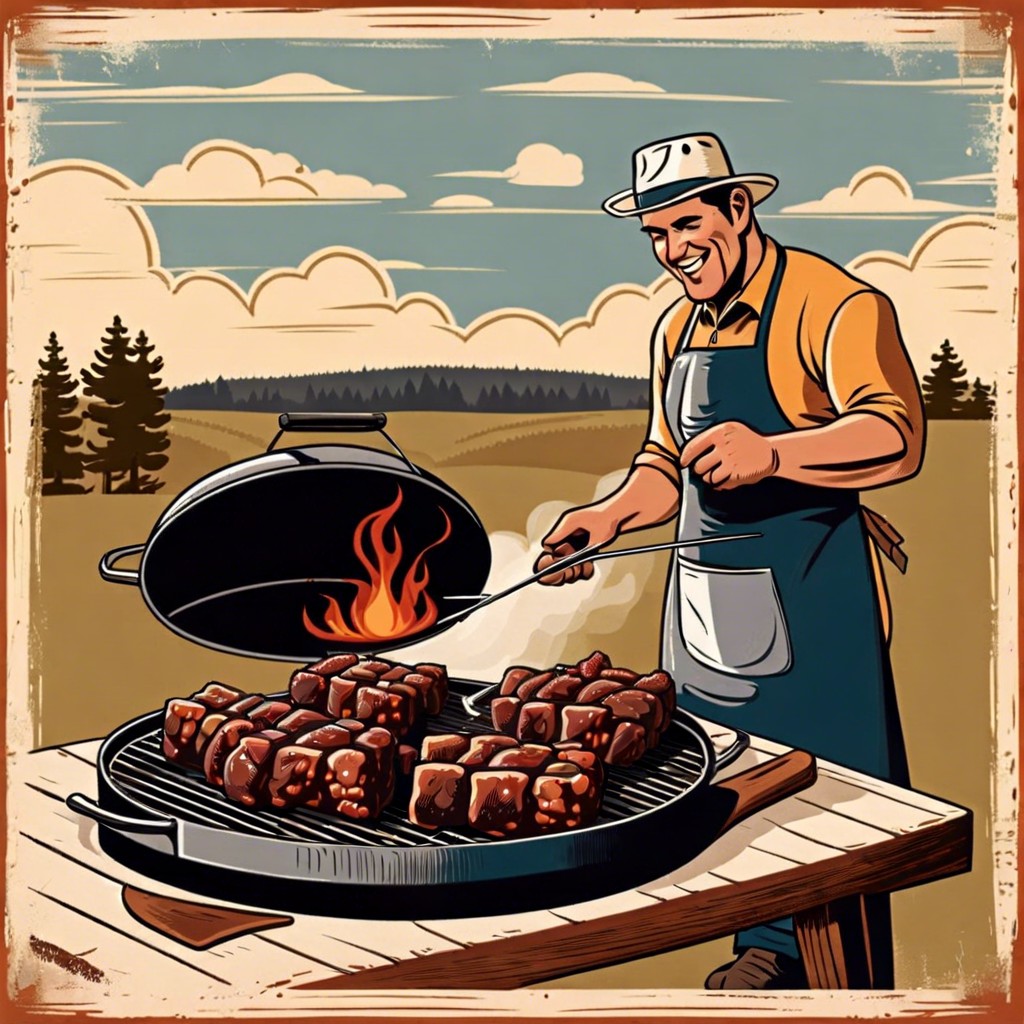Burnt ends are a tantalizing barbecue delight, and this article will unveil what they are, their origins, and why they’re a coveted item among BBQ enthusiasts.
Key takeaways:
- Burnt ends originated in Kansas City and were initially scraps from smoked brisket.
- They are made from the fatty point section of a brisket, with a crispy exterior and tender interior.
- To make burnt ends, smoke the brisket until tender, cube the point section, and return to the smoker with seasoning and sauce.
- Burnt ends have evolved from a pitmaster’s snack to a popular dish with creative seasonings and sauces.
- Store burnt ends in an airtight container in the fridge for up to four days, or freeze for up to three months.
Historical Account

Tracing the roots of burnt ends takes us to Kansas City, Missouri, a barbecue bastion known for its mouth-watering traditions. Originally, these crispy, smoky morsels were the serendipitous byproduct of smoking brisket, the tough cut of meat from a cow’s breast or lower chest.
Pitmasters initially snipped these charred tips off to avoid serving the overcooked pieces to customers. However, the dish was too delicious to discard. Recognizing their flavorful potential, savvy barbecue joints began offering them as a coveted delicacy.
With a rich history embedded in American barbecue culture, burnt ends have transformed from a pitmaster’s snack into a sought-after staple at smokehouses and barbecue competitions.
What Are Burnt Ends Made From?
Traditionally, burnt ends hail from the point section of a brisket, the fattier half of this prized cut of beef. After long, slow cooking, the point develops a crispy, almost charred exterior, packed with flavor.
Pitmasters, in a stroke of genius, cube this outer layer into bite-sized pieces, imparting a double dose of smokiness by returning them to the smoker. This extra step heightens the contrast between the caramelized bark and the tender, juicy interior.
While brisket is the classic choice, there’s a growing trend to apply the ‘burnt ends’ treatment to other proteins such as pork belly or even non-traditional items like vegetables for a smoky, savory twist.
How to Make Burnt Ends
Crafting these bite-sized morsels begins with a whole packer brisket, which is smoked low and slow until it’s as tender as a whisper from a summer breeze. After the brisket reaches a perfect internal temperature, usually around 195°F, the point is where the magic happens. This fattier section is cubed into squares, contrastingly known as “burnt” ends for their gloriously caramelized exterior.
Next, toss the cubes with additional seasoning and sauce — this is barbecue’s nod to painting one’s masterpiece. But brush lightly; the goal is to complement the beef’s rich flavor, not overpower it. Return them to the smoker at around 250°F. It’s all about patience here, as the burnt ends absorb smoke, glaze, and transform into sticky, charred nuggets of joy.
- Monitor closely and turn occasionally. This is to kiss each side with equal amounts of heat and smoke.
- The endgame? Look for edges that are strikingly caramelized with a slight tackiness to the touch, ensuring the inside stays moist.
- Listen to the burnt ends. They will sing crackling songs of readiness when they’re done, usually after an hour or two.
Remember, perfection can’t be rushed, and every brisket writes its own tale of doneness.
The Burned Edge Evolves
Once relegated to the status of a scrappy BBQ byproduct, burnt ends have undergone a transformation worthy of Cinderella. Originally tossed together from odds and ends of brisket, these morsels have stepped out from the shadows into the spotlight.
Initially, the crispy, fatty pieces snipped from the point of a smoked brisket were considered a pitmaster’s snack. Today, they’ve gained a devoted following, prompting many barbecue joints to craft them deliberately, rather than stumble upon them by serendipity.
Creativity in seasoning and sauces has propelled these bites further into culinary stardom. While traditionalists may stick to a simple salt and pepper rub, the modern twist includes a variety of spice blends and glazes, often adding a hint of sweetness to counterbalance the intense smokiness.
As a testament to their growing popularity, burnt ends have also found their way into other dishes. They are more than a stand-alone treat – chefs use them to elevate everything from baked beans to mac and cheese, infusing these dishes with the burnt ends’ signature depth of flavor.
In this ongoing evolution, one thing remains clear: the once overlooked burnt ends are now celebrated—a testament to the notion that sometimes, it’s the simplest parts of a dish that can make the most noise.
How To Store Burnt Ends
Keep the smoky goodness fresh by popping your burnt ends in an airtight container; they’ll play nice in the fridge for up to four days.
Freezing them? Wrap tightly in aluminum foil, then slide into a freezer bag. Press out all the air for a snug fit and stash them for up to three months.
Thaw in the fridge when you’re ready for round two, and reheat gently to maintain their delectable crust and juicy interior.
Remember, these morsels deserve a grand encore, not a microwave sprint.